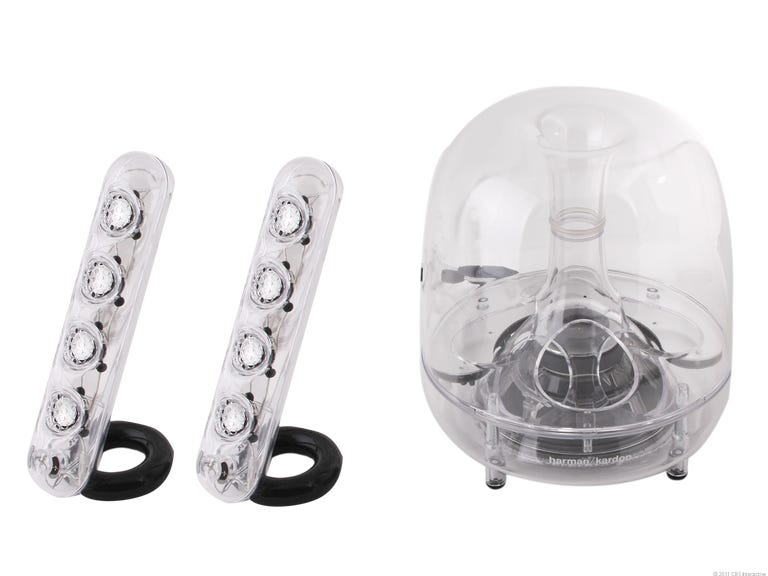 Why You Can Trust CNET
Why You Can Trust CNET Harman Kardon SoundSticks III review: Harman Kardon SoundSticks III
Harman Kardon SoundSticks III
The Harman Kardon SoundSticks III speakers don't offer much more than the first SoundSticks and their SoundSticks II sequel we've already reviewed, but who are we to argue with a design that was deemed worthy of the New York Museum of Modern Art's permanent collection? The SoundSticks III speaker system keeps the same internal components we loved about its predecessors--four 1-inch drivers mounted vertically in dual 10-watt satellite speakers and drawing power from a 20-watt subwoofer that sits on the floor. Unfortunately, Harman Kardon didn't change any of the things we found irritating about the SoundSticks' first two iterations, so you still have to reach down to the subwoofer to turn off the system, but if you can overlook some missing details and don't mind its capacitive volume buttons, the SoundSticks III speakers are sure to earn you accolades from jealous listeners.
The Good
The Bad
The Bottom Line
Design
The original SoundSticks debuted back in the year 2000 around the same time that Apple introduced the clear iMac G3 computer, and there's a reason the two devices carry a similar aesthetic: both started as an image in the mind of Apple's current lead designer, Jonathan Ive.
The current SoundSticks III use the same clear plastic transparency for the subwoofer and satellite combination, and many have compared the pale light inside to the glow of a jellyfish. This time around, Harman Kardon has lowered the intensity of the internal blue lights so they aren't as distracting as on the last two models.
The two transparent, 10-watt satellite speakers each have four 1-inch drivers built into a vertical column and look almost exactly the same as the Soundstick II speakers, with the exception of a new black color for the base rings. The rings let you adjust the angle of the satellites, which helps if the height of your desk is incongruous with your chair. The satellites are wired to open ports on the bottom of the 10.2x9.2-inch subwoofer and link together using a cable wrapped in transparent housing for extra protection against pets, humans, and whatever else might be chewing up wires around your house. The sub's open 1/8-inch input jack also means that anyone with a male audio output can play music on the SoundSticks, and setting up the system to play from a computer only took us a few minutes.
Capacitive-touch volume buttons may have blown skirts up back in 2000, but the inability to view incremental volume levels is pretty irritating today, and on multiple occasions we found ourselves pumping the volume up to eardrum-piercing levels by accident as a result of the ultrasensitive buttons. We can only hope that Harman Kardon will wise up and build the next SoundSticks with a dedicated volume knob.
Another gripe is the lack of a headphone jack, although you can purchase a dual-sided 3.5-inch audio cable for the output jacket. Finally, the bass-level controls are on the subwoofer itself, and the dial also doubles as a power button, which is annoying to turn off every night if you like to sleep in total darkness.
Performance
The SoundSticks continue to garner positive marks from users after 10 years because they're not just a pretty design--the 2.1 speakers are resistant to distortion even at extremely loud volumes, and our bass-centric test track (Skrillex's "First of the Year ") sounds crisp and balanced despite a rather limited frequency-response range of 44Hz to 20Hz, compared with competing speakers like the Audioengine 2 speakers.
We also noticed zero added hissing on sibilant consonants and very little audible static between tracks. The SoundSticks III sound equally powerful when playing 192K-encoded MP3 music tracks, during PC gameplay, and most especially in scenes from the most recent silver-screen version of "King Kong." In each instance, we pushed the maximum volume up incrementally and found no degradation in sonic clarity and bass rumble.
Conclusion
Harman Kardon drops the price of the SoundSticks III from $200 down to just $170, earning our buying recommendation for music fans and dedicated Ive followers alike. Despite a few shortcomings, the SoundSticks system remains one of the best-sounding, and best-looking, PC speaker systems under $200.


